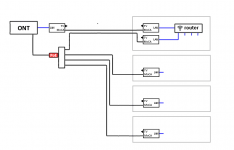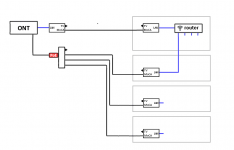Hi,
I have Cox home internet service. I am using MoCA to run internet to a WiFi router and to a second device.
I've put a wiring diagram below.
The WiFi router is working fine but the second device is not getting internet. This is true regardless of which second device I use (PC, Roku, etc.). It is also true when I connect the second device using a shorter cable that runs right into the amp/splitter. And it's true even after I replaced the MoCA adapter.
The problem started when I upgraded my cable modem to a newer model.
Does anyone have thoughts on what might be the problem with my configuration?
I am out of ideas here and would really appreciate any suggestions.
Thanks.

I have Cox home internet service. I am using MoCA to run internet to a WiFi router and to a second device.
I've put a wiring diagram below.
The WiFi router is working fine but the second device is not getting internet. This is true regardless of which second device I use (PC, Roku, etc.). It is also true when I connect the second device using a shorter cable that runs right into the amp/splitter. And it's true even after I replaced the MoCA adapter.
The problem started when I upgraded my cable modem to a newer model.
Does anyone have thoughts on what might be the problem with my configuration?
I am out of ideas here and would really appreciate any suggestions.
Thanks.





